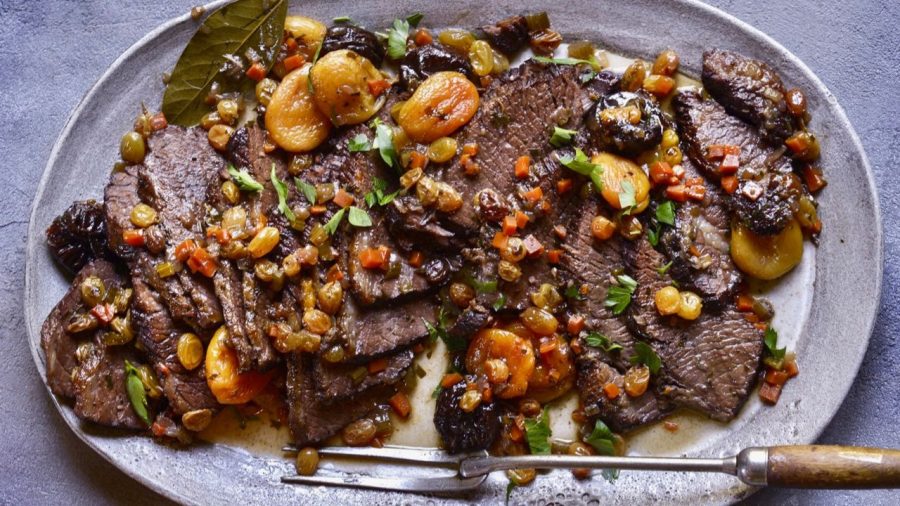Aunt Annette’s Holiday Brisket with sweet wine and dried fruits
Published September 22, 2022
One Bonus Recipe
Last April, we reported how Jewish BBQ master Steven Raichlen had brought his cooking show to St. Louis, shooting an entire season of shows at Union Station. He is also the author of many a cookbook including “The Brisket Chronicles.” Raichlen was kind enough to send us his favorite brisket recipe to share with our readers.
Aunt Annette’s Holiday Brisket with sweet wine and dried fruits
Long before my indoctrination into barbecue, I ate brisket. So did every other Jewish kid in the neighborhood.
Brisket was the ultimate holiday dish, and nobody made it better than my Aunt Annette Farber. Working in a kitchen that would be deemed hopelessly primitive today, Aunt Annette grated mountains of potatoes on a hand grater to produce latkes that defied physics. (They were simultaneously feather light and properly leaden.)
She hand-cranked a meat grinder to turn out gefilte fish I still dream about a lifetime later. But the star of her repertory was brisket—braised for hours with onions and carrots and sweet red kosher wine (was there any other kind?). Lavished with lemons, apricots, prunes, and other dried fruits, it was the sort of sweet-salty, meaty-fruity mashup typical of so much Ashkenazi cuisine. Aunt Annette served it at Rosh Hashanah (the dried fruits presaged a sweet New Year).
She served it at Hanukkah and Passover. I imagine she serves it still to hungry multitudes in heaven. These days, my family’s more likely to eat our brisket slow-smoked like they do in Texas, but at least once a year we dust off Aunt Annette’s recipe for a braised brisket that transcends wood smoke.
YIELD: Serves 6 to 8
PREP TIME: 15 minutes
COOKING TIME: 3 to 4 hours
METHOD: Braising
HEAT SOURCE: Oven
YOU’LL ALSO NEED: a Dutch oven or roasting pan with a tight lid just large enough to hold the brisket; gravy boat with a fat separator (the sort that allows you to pour the broth off from the bottom, leaving the fat on top; optional)
WHAT ELSE: This recipe calls for a technique that may surprise all you barbecue buffs out there. You carve the brisket midway through the cooking process when it’s still firm enough to slice neatly. The slices finish cooking in the braising liquid.
1 brisket flat (3 to 4 pounds)
Sea salt and freshly ground black pepper
2 tablespoons canola oil
1 large onion, finely chopped
2 carrots, finely chopped
2 ribs celery, finely chopped
2 cloves garlic, peeled and finely chopped
1/4 cup chopped fresh flat-leaf (Italian) parsley
1 1/2 cups sweet kosher wine (Concord grape wine, such as Manischewitz)
2 1/2 cups beef or chicken stock (preferably homemade) or water, plus extra as needed
2 dried bay leaves Kylie—either dried or fresh will work fine. I’d just say “bay leaves”
1 1/2 cups dried apricots
1 1/2 cups pitted prunes
1 cup golden raisins
- Preheat the oven to 350°F.
- Using a sharp knife, trim the brisket, leaving a 1/4-inch layer of fat. Generously season the brisket on all sides with salt and pepper. Heat the oil in a Dutch oven or roasting pan over medium-high heat. Add the brisket and cook, turning once, until browned on both sides, 4 to 6 minutes per side. Transfer the meat to a platter and pour out and discard all but 3 tablespoons of fat in the pan.
- Add the onion, carrots, celery, garlic, and 3 tablespoons of the parsley and cook over medium-high heat until soft and browned, 5 minutes.
- Return the brisket to the pot, spooning half the vegetables on top. Add the wine, broth, and bay leaves. Tightly cover the pot (if using a roasting pan, cover it tightly with aluminum foil), place it in the oven, and braise until semi-tender, 1 1/2 hours.
- Remove the pot from the oven, uncover it, and transfer the brisket to a welled cutting board; set the pot aside. Using a sharp knife (an electric knife works great), thinly slice it across the grain. Stir half of the apricots, prunes, and raisins into the juices in the pot. Using a spatula, neatly lay the sliced brisket on top. Pour in any juices from the cutting board and arrange the remaining dried fruits on top. Season with salt and pepper. Add stock as needed just to cover the meat and fruit.
- Cover the pot and return it to the oven. Continue braising the brisket until the meat is tender enough to cut with a fork, another 1 1/2 to 2 hours. Add stock or water as needed to keep the meat and fruits moist. If there’s too much cooking liquid, uncover the pan for the last half hour to allow some of the juices to evaporate.
- Transfer the brisket to a platter. Using a slotted spoon, transfer the fruits and vegetables to the platter and arrange them around the meat. Pour the pan juices into a gravy boat with a fat separator. (If you don’t have one of these, pour the gravy into a bowl or measuring cup and skim the fat off the top with a ladle.) Spoon some of the gravy over the meat and fruit, serving the rest on the side. Sprinkle the remaining 1 tablespoon parsley over the meat and get ready for Jewish holiday awesomeness.















